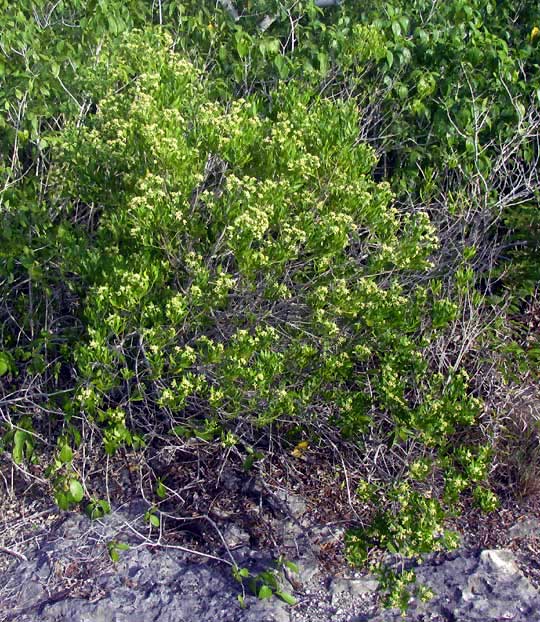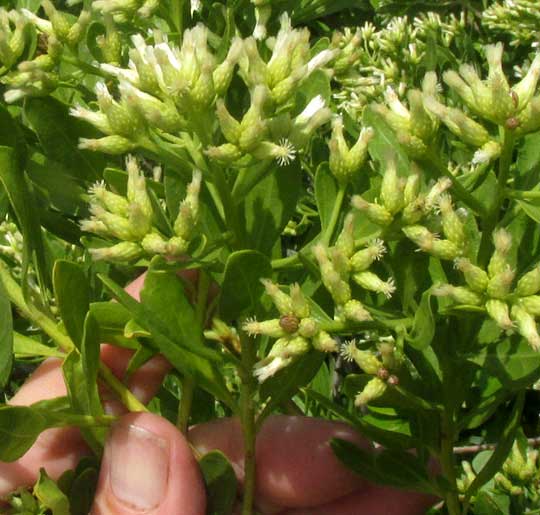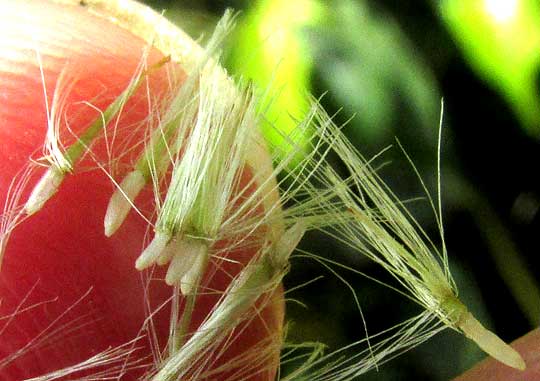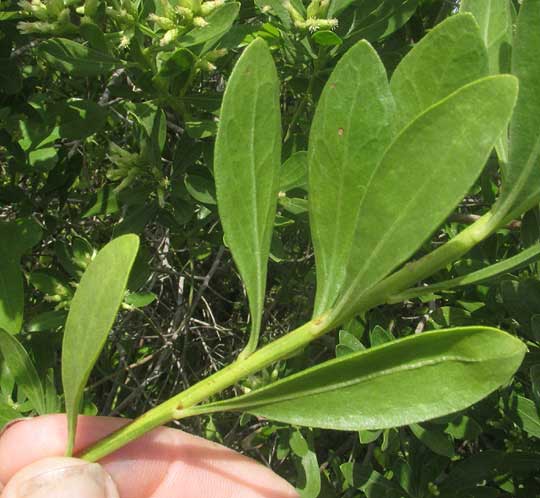Excerpts from Jim Conrad's
Naturalist Newsletter
from the July 12, 2015 Newsletter issued from Río Lagartos, on the Yucatan Peninsula's northern coast (~N21.60°, ~W88.16°), Yucatán state, MÉXICO
BROOMBUSH FALSEWILLOW
At mangrove edges and out in the marshes nowadays a much-branching, spreading bush averaging about eight feet tall (2.5m) is so loaded with yellowish-white flower clusters that at a distance the whole bush seems yellowish white, like the one below:

Up close we see that the shrub's heads are like those of the North's eupatoriums and bonesets, seen below:

With such flower clusters this is clearly a member of that subgroup of the Composite or Sunflower Family, the Asteraceae, in which the individual heads are made of packed-together disc flowers, with no petal-like ray flowers. A close-up of some heads is shown below:

There you see cylindrical disc flowers projecting from pale green, urn-shaped structures called involucres, which are composed of overlapping scales called phyllaries. Notice that some of the tiny disc flowers have five, curled-back corolla lobes that barely reach beyond the involucres' tops. Other flowers project well above these shorter ones. The short disc flowers are functionally male flowers not producing fruits, while the taller ones are female flowers, some with stigmas exposed to receive pollen from other flowers. Flowering heads on some bushes hold cypsela-type fruits that are almost mature and ready to launch onto the wind with their white parachutes, as shown on the tip of my finger, below:

All these details -- the plant's bushy woodiness, the flowering heads with only disc flowers, the prodigious number of flowers, the cypselae with white-hairy parachutes -- point to a well known genus, the largest of all genera of the huge Composite or Sunflower Family, the genus Baccharis, with over 500 species. Baccharis species, known generally as baccharises, occur throughout the Americas, but mostly in the tropical regions of Brazil, Argentina, Colombia, Chile and Mexico. In North America, Baccharis halimifolia, known as the Sea-myrtle or Eastern Baccharis, commonly occurs on the East Coast's and Gulf's Coastal Plain.
But our present Baccharis isn't that one, as is obvious from the leaves shown below:

For a Baccharis, those leaves are fairly unusual in that they're somewhat fleshy, bear no teeth or lobes (they're "entire,") and usually are broadest above their middles. Many Baccharis species have very narrow blades.
Our present baccharis is BACCHARIS DIOICA, found in mangroves and low spots or "hollows"between coastal dunes and hammocks -- hammocks being little islands of woody vegetation surrounded by marsh -- along Mexico's Gulf of Mexico coast, southern Florida, and the Caribbean area. The semi-succulent leaves with entire margins make it easy to identify. The Flora of North America calls it Broombush Falsewillow, the name "falsewillow" being a general term used for certain bacharises, and "broombush" alluding to the fact that it looks like certain unrelated bushes called brooms or broombushes. In other words, it's a name an editor someplace made up but Broombush Falsewillow is the best name we have in English.
Broombush Falsewillow doesn't seem to be used medicinally or as an ornamental, but I can tell you that bees and other small insects cherish its flowers' nectar, and nowadays keep the bushes buzzing with activity. Our local Maya bee keepers are grateful for their presence.